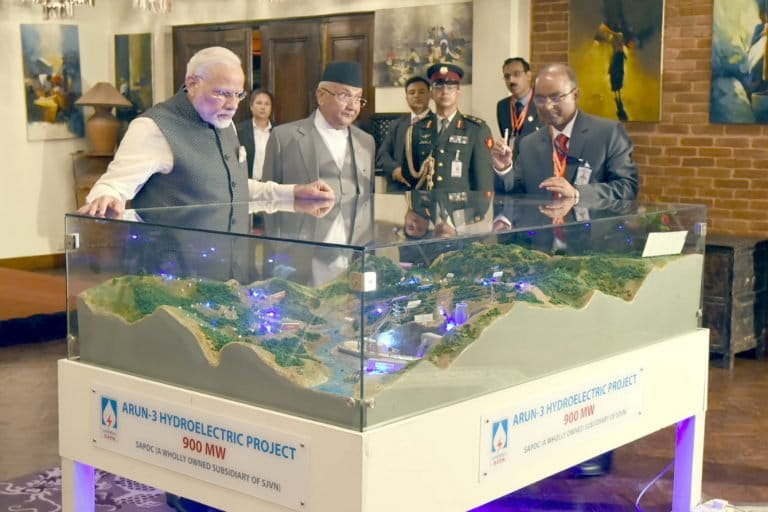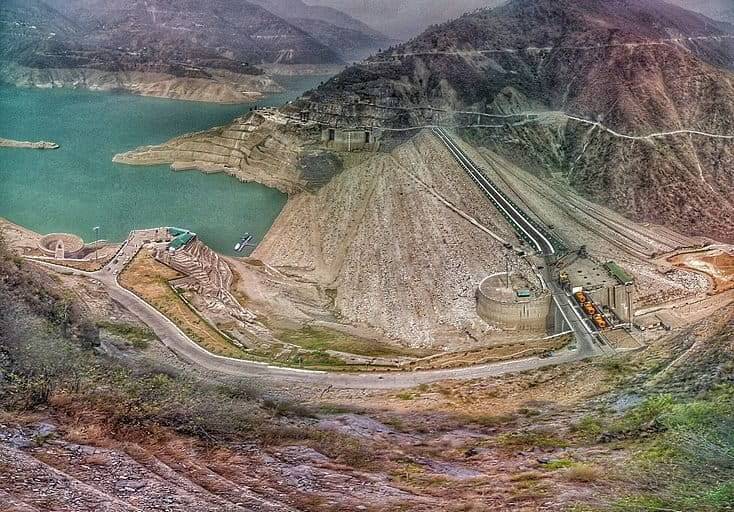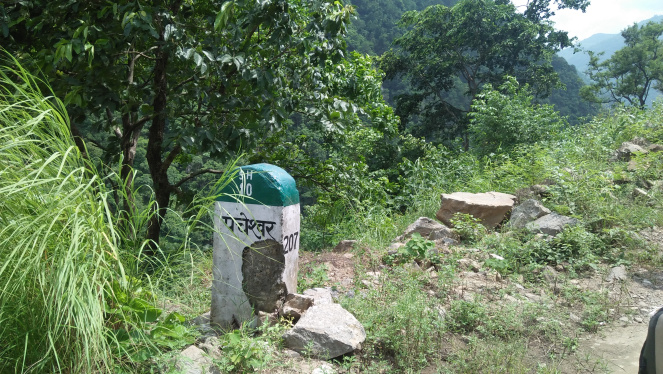- India and Nepal are pursuing a 5,040 MW hydropower project on River Mahakali on the India-Nepal border. The project requires a total area of 14,100 hectares and once completed will have an irrigation potential of about 430,000 hectares.
- The scale of the Pancheshwar Multipurpose Project (PMP) is so far unprecedented in India. It comprises a 315-metre dam which will be among the highest in the world when completed.
- While the project is a strategic tool for India to maintain influence in the region, environmentalists are raising concerns about the impact of the project in the disaster-prone and environmentally-sensitive Uttarakhand region.
Is it going to be a new wave of development in the region or is it an environmental disaster in the making?
The 5,040 megawatt (MW) Pancheshwar Multipurpose Project (PMP), planned on the India-Nepal border, got a new lease of life during Prime Minister Narendra Modi’s recent visit to the neighbouring country. However, there are still several concerns around the project and a tough road lies ahead before it finally sees the light of the day.
The joint project is envisaged on the River Mahakali, known as Sarada in India, at a location where the river forms the international boundary between India and Nepal. It is one of the highlights of the Mahakali Treaty signed between the two nations in February 1996. The aim of the project is energy production, irrigation benefits and flood control.
Being a joint project, it has been a regular feature during India-Nepal diplomatic meetings. In August 2014, during his Nepal visit, Modi and his Nepal counterpart Sushil Koirala agreed to speed up the project. It was decided to finalise the detailed project report of the PMP within six months and begin its implementation within one year. However, four years later, both are yet to happen.
Earlier this month, Modi visited Nepal and in a joint statement after the meeting, the two nations reiterated the importance of “advancing cooperation in water resources for mutual benefit in areas such as river training works, inundation and flood management, irrigation and to enhance the pace of implementation of ongoing bilateral projects.” Modi and his Nepal counterpart K. P. Sharma Oli also jointly laid the foundation stone of 900-MW Arun-III hydroelectric project in Nepal.

These projects are of high significance for India in view of China’s growing influence in Nepal. In fact, the Indian government has already been using large-scale transboundary hydropower projects as an efficient tool for diplomacy.
So far, the Indian government has constructed three hydroelectric projects in Bhutan totalling 1,416 MW which are operational and exporting surplus power to India. As per agreements signed with Bhutan, India will assist Bhutan in developing a minimum of 10,000 MW of hydropower by 2020.
India’s former foreign secretary Lalit Mansingh stressed that India has not had the same success in implementing international projects with Nepal compared to countries like Bhutan.
“We have not had same degrees of success with Nepal, not because of environmental issues but because of political differences and other problems. I take it that if we do a project with Nepal, the Nepalese government will apply its own scrutiny on the environmental impact and we on our side will check what the impact will be on India while implementing such projects,” he said.
While emphasising on international projects that India is involved in with its neighbours like Myanmar and even Afghanistan, Mansingh said he believes environmental concerns are not a major issue, except in the case of hydroelectric projects.
A large-scale project like the PMP though, is bound to run into controversy especially when located in a state like Uttarakhand which is known for the fragile mountain region.
Why exactly is it a bad idea?
“This is a project which is being planned on an unprecedented scale but the unfortunate part is that it is being pushed without giving a detailed thought to the safety of people, damage to the environment and economic viability. The project has huge land requirement and will result in India’s one of the biggest reservoir but it is located in an area that is known for high seismic activity,” said Himanshu Thakkar, coordinator of the South Asia Network on Dams, Rivers and People (SANDRP), a network of organisations and individuals working on issues related to the water sector, specifically associated to large dams.

“Uttarakhand regularly witnesses extreme weather events and it is also home to the fragile part of the Himalayas and yet we want to go ahead with it. The project site is also an earthquake-prone area. It doesn’t even include any assessment of climate change on the project. It is risky, unviable and unsustainable. This is nothing but a disaster in the making,” he added.
His concerns may not be entirely off the mark as Uttarakhand – a highly disaster-prone state – over the years has faced many extreme weather events. It experienced two major earthquakes — Uttarkashi (1991) and Chamoli (1999) — each of magnitude more than six on the Richter scale (unit to measure the intensity of earthquakes).
Landslides, forest fires, cloudbursts and high-intensity rainfall leading to floods are among the other problems faced by the state. In June 2013, severe floods in Uttarakhand resulted in deaths of over 5,000 people and damaged property worth billions of rupees.
India has been taking various steps to ease the rules around the project. For instance, in May 2017, an expert panel of India’s Ministry of Environment, Forest and Climate Change (MoEFCC) had held that setting up a joint mechanism with Nepal, to assess the project’s environmental impact would further “delay the process of this important international project.”
“Hence, let the public hearing be conducted based on the EIA report for Indian portion and the project proponent may approach the (environment) ministry for final appraisal for environmental clearance,” noted the minutes of the panel’s meeting.
However, the project still requires environment, forest and wildlife clearance from the MoEFCC and none of them has been secured so far. It requires wildlife clearance as the distance from the tip of the submergence in Pithoragarh district is within 300 m from the Askot Musk Deer Wildlife Sanctuary. In accordance with a December 2006 order of the Supreme Court of India, it is a policy that if any project is located within the eco-sensitive zone around a wildlife sanctuary or a national park or in absence of such a marked zone, within a distance of 10 kms from its boundaries, that project requires clearance from the standing committee of the National Board for Wildlife.

Last year, over 40 environmentalists and activists, including Thakkar, had written to the MoEFCC raising objections against the way public hearing for the Pancheshwar project was being conducted.
In 2010, a study by the Institution of Environmental Sciences had warned against the project stating that the Pancheshwar project site and the substantial area affected, both upstream and down, is of significant ecological, cultural and spiritual as well as tourism importance.
“Much of this would be lost were the dam to proceed,” the study had said.
It also said the “negative environmental consequences of the proposed Pancheshwar Dam would be substantial and long-lasting, and would affect people and ecosystems over a wide geographical scale” threatening not only high-priority nature conservation areas and the general river ecosystem downstream, but also the livelihoods of many people, both local and across the catchment, by degrading the ecosystem services provided by the catchment ecosystem.
“The impacts of earthquakes on dam integrity also seem to have been overlooked, despite the likely implications of the massive weight of the proposed reservoir on a highly active earthquake zone,” the study emphasised.
Apart from the environmental issues, Thakkar said the project may not be economically viable as well.
“The electricity that will be produced from this project will cost between Rs. 8-10 per unit. Who will buy it at such an expensive price when power is available for Rs. 3 per unit in the country? It will result in an irreversible change in the local ecology and increase overall risks in the region,” said Thakkar.

Environmental expert Bharat Jhunjhunwala said in terms of water the ecological cost of the project is huge and there are alternative available but not many are interested.
“The Tehri project was opposed mainly on geological concerns. It is, of course, difficult to predict what will happen in future. But no hydropower project has suffered due to earthquakes. In 2013, some small ones were washed out but not because of earthquakes,” said Jhunjhunwala.
“I think the bigger issue is about alternatives. I did a study on Tehri project which states that if the area of Tehri project is converted to solar power farms then the power produced will be 200 times more than what is produced from Tehri. As much as power is concerned solar is a much better alternative. So ground for 5,000 MW (by Pancheshwar) does not hold,” he explained.
“As far as water is concerned I again think that the ecological costs are very large. I think much better and benign alternative is to do water harvesting in plains. But the difficulty is that the alternatives do not involve big contracts. But no one makes money in decentralised ways and thus none is interested. The objectives of a project like Pancheshwar are – water and power – but better alternatives are available. I think the strategic impact is the real issue,” he added.
Pancheshwar aimed to be India’s largest hydropower project
As per the Environmental Impact Assessment (EIA) report of the project, the “Pancheshwar dam site was first identified during the hydroelectric survey of potential sites on the Mahakali River conducted by the erstwhile Central Water and Power Commission of India in 1956.”
It envisages a “main rock fill dam at Pancheshwar, 315-metre high from the deepest foundation level, forming about 80 km long reservoir, with a surface area of 116 km square and a total gross storage volume of about 11.35 billion metre cube.”

The dam will be built across the River Mahakali, 2.5 kilometres downstream of the confluence of the rivers Sarju and Mahakali and, about 70 km upstream of the Tanakpur town (India). As per January 2017 estimates, the project cost is Rs. 401.84 billion (Rs 40,184 crore) but it is expected to climb up to Rs. 500 billion (Rs 50,000 crore) by the time project starts.
When built, Pancheshwar will be among the tallest dams in the world. Currently, the tallest dam is China’s Jinping-I Dam standing at 305 metres (1,001 feet) constructed on the River Yalong. India’s tallest dam at present is Tehri dam, also in Uttarakhand, which stands at a height of 260.5 metre (855 feet).
The project includes two underground powerhouses of 2,400 MW each with a total installed capacity of 4,800 MW. The plan also includes a re-regulating dam downstream at the Rupaligad site with two underground powerhouses of 120 MW each having a total installed capacity of 240 MW to even-out main dam releases to achieve continuous river flow conditions.
It also has an expected irrigation potential of 170,000 hectares in Nepal and 259,000 hectares in India and flood mitigation potential.
A total area of 14,100 hectares — 9,100 hectares in India and 5,000 hectares in Nepal — is required for construction of various parts of the project. It also involves about 1,600 hectares of forest area.
A tough road lies ahead
The road to secure various clearances for the project and its construction is not going to be an easy task.
India has had a history of public protests against such huge projects. For instance, when India’s current tallest dam, Tehri, was being constructed, there was a people’s movement against it in the 1980s and 1990s. In another example, the protest against another large-scale project in the country, the Sardar Sarovar dam on the River Narmada, still continues.

PMP may not be any different as affected families face an uncertain future. A total of about 31,023 families will be losing homestead and land due to reservoir submergence.
One such family will be of Pradeep Giri, 20, who lives with his family in village Dubola Birtola in Uttarakhand.
“If this project is built, all our land and our shop will be submerged. Things are not clear as yet. Even if we get a compensation for our land, we will be uprooted from the place we have been living our whole life. Money is not everything. Where will we get such life?” said Giri.
“After the accepted mistake called Tehri hydroelectric project, such a project should have never been even conceived in such a vulnerable area. Residents have registered strong protests in public hearing and if it is not scrapped, it will reach courts and face national protests as well,” said Mallika Bhanot of Uttarakhand-based Ganga Ahvaan.
The project is also expected to face legal issues as activists believe the public hearing and EIA conducted to seek clearance for the project were “shoddy”.
“The project will surely land in legal trouble as well due to the shoddy EIA report which does not include many adverse impacts of the project and the poorly conducted public hearing which was designed to keep people out of the consultative process,” said Thakkar.
Mansingh too feels there will be a close environmental scrutiny. “This time, when we start working at these old proposals, I think there will be much closer scrutiny of the environmental impact because we know that on our India side we have virtually suspended major hydroelectric projects. With Nepal, I am sure that this is an angle that has to be looked into very carefully before we get into the construction phase,” he said.